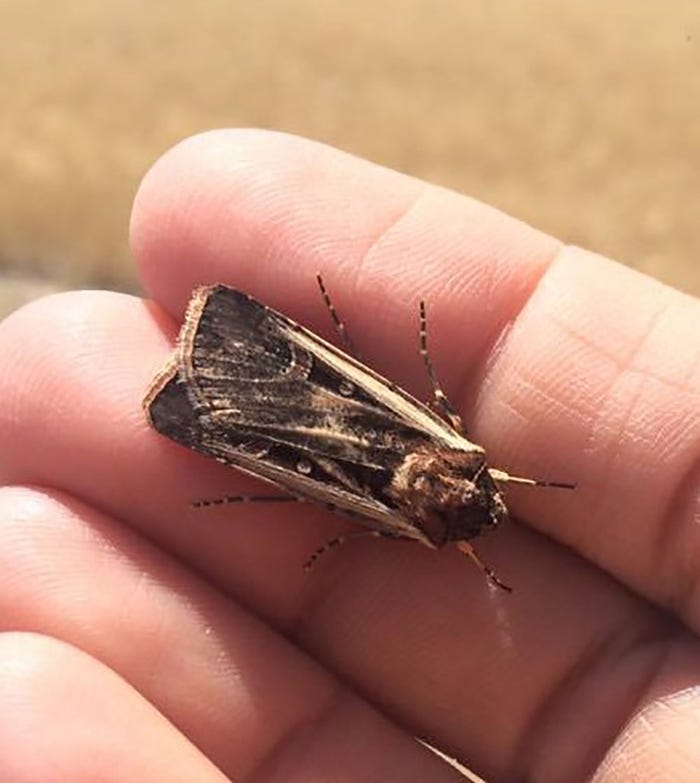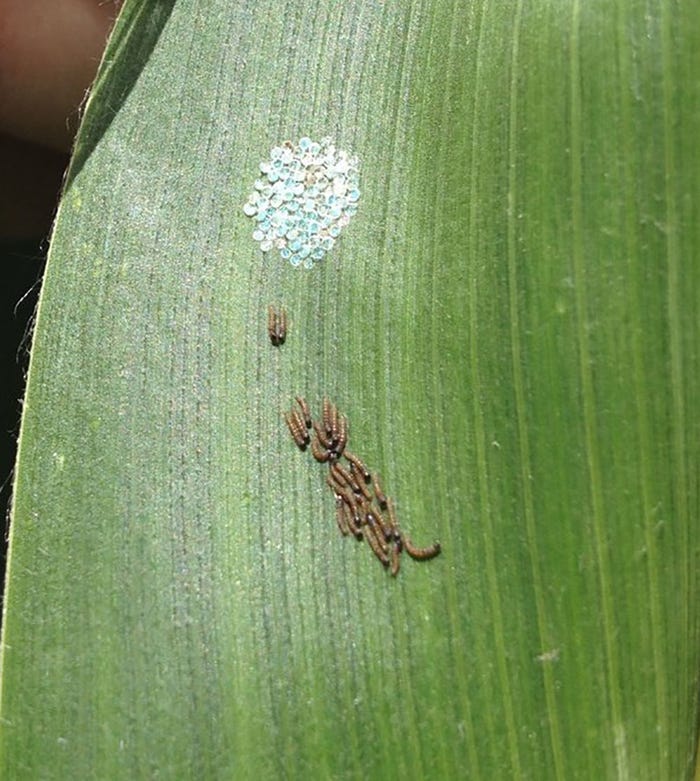April 16, 2018

Source: University of Nebraska-Lincoln
The western bean cutworm (WBC) is an economically important pest of corn and dry beans. In corn, damage is caused by direct feeding on developing kernels, which causes yield loss and potential secondary fungal infections. Control tactics have focused primarily on using Bt traits that are effective at controlling WBC larvae or applying foliar insecticides after scouting has determined that the economic threshold has been met. Scouting is critical to determine whether the economic threshold has been reached (in Nebraska the threshold is 5-8% of plants with an egg mass or larvae) and to determine appropriate application timing (recommended application time is when 95% of the plants in a field have tasseled).
Insecticide applications will only be effective prior to larvae entering the ear, as larvae must come into contact with pesticides either directly during applications or through residuals on the plant surfaces. Thus, scouting and application timing are critical. There are numerous chemicals labeled for WBC larval control. Effective management of WBC depends on selecting the best product for your farm and rotating insecticide mode of action to prevent or delay the development of resistance.
In this study we evaluated the efficacy of foliar insecticide treatments for the control of western bean cutworm in field corn plots during 2015-2017.



Experimental Design
Between four and 14 insecticide treatments (including an untreated control) were tested each year. The 2015 field trial was located at the West Central Water Resources Field Laboratory near Brule, while the 2016 and 2017 trials were located at the Henry J. Stumpf International Wheat Center near Grant. Corn hybrids planted for this study had no Bt traits that protected against the western bean cutworm. Plots were 20 feet (eight rows) x 35 ft planted at 32,000 seeds/acre. In all three years, plots received irrigation, fertilization, and weed management inputs following standard agronomic practices for the region, with no insecticide applications other than the experimental treatments.
Scouting and Insecticide Applications
In all three years, plots were scouted weekly after the onset of moth flight for the presence of WBC eggs and larvae and were treated after the economic threshold was reached. Treatments were made on July 31, 2015, July 25, 2016, and July 24, 2017. Applications were made with a backpack sprayer with an 8.3-foot handheld boom fitted with six TeeJet AIXR 11002 yellow nozzles spaced 20 inches apart, at 15 gpa carrier volume with 30 psi pressure maintained with a CO2 propellant. Insecticide treatments were applied to the middle four rows of each plot with a single pass at 3 mph.
In 2017, additional scouting was conducted 7, 14, and 21 days after application (DAA), at which time five randomly selected plants in the center of each plot were destructively sampled and the numbers of hatched and unhatched WBC egg masses and live and dead larvae were recorded.
Ear Assessments
To determine if insecticide treatments prevented WBC damage, 10 ears from the central two rows and interior 22 feet of each plot were randomly chosen and removed along with the husks on August 27, 2015, August 29, 2016, and August 23, 2017. The ears were husked and examined in the laboratory to determine feeding damage, measured in square inches, to aborted kernels at the ear tip and harvestable kernels. The presence of WBC larvae and secondary fungal infection in the ears was also recorded.
Results
In 2015, all foliar insecticide treatments significantly reduced ear-feeding damage compared to the untreated control (Table 1). In fact, 0% of corn ears from all three insecticide treatments were infested with WBC larvae and no feeding damage to either aborted ear tip kernels or harvestable kernels was observed. High larval mortality caused by a temporal mismatch between crop growth stage and larval development likely reduced ear infestation rates and feeding damage. Early instars of WBC survive best on fresh tassel tissue, which was not available during early larval development due to weather delays in planting.
In 2016, all foliar insecticide treatments significantly reduced ear feeding damage to aborted ear tip kernels compared to the untreated control (Table 2). The highest rate of Steward performed the best in terms of reduction in ear tip and harvestable kernel damage, percent ear infestation, and percent of ears with secondary fungal infections. Feeding damage to aborted kernels was significantly lower at the highest rate of Steward compared to two rates of Mustang Maxx and the lower rate of Hero. For harvestable kernels, all products provided significant reduction in damage, except the two lower rates of Mustang Maxx.
Results in 2017 were different than those from the previous trials. In 2017, all foliar insecticide treatments failed to significantly reduce ear feeding damage to aborted ear tip kernels and harvestable kernels compared to the untreated control (Table 3). The efficacy and residual activity of the foliar insecticide treatments tested may have been negatively impacted by inclement weather. Of the 140 larvae counted on plants at 7, 14, and 21 DAA, over half (52.9%) were dead at 7 DAA, whereas only 16.1% and 0.0% larvae were dead at 14 and 21 DAA, respectively (Table 4).
In addition, although results from the 2016 trial showed that fungal infection is related to WBC infestation, very few ears in the 2017 trial had fungal infection. Plots treated with the lower rate of Brigade were the only plots where fungal infection was observed.
Take-Home Points
1. The combination of high larval mortality from both insecticide applications and developmental mismatch with the host plant is believed to have effectively controlled WBC in 2015.
2. When trial conditions were good in 2016, the best performance in terms of reduction in ear tip and harvestable kernel feeding, percent ear infestation, and percent of ears with secondary fungal infections was with the highest rate of Steward.
3. Environmental conditions may impact the efficacy and residual activity of foliar insecticides applied to control WBC. For example, heavy rainfall in the days after foliar insecticide application in 2017 likely reduced their efficacy against WBC
4. The WBC infestation rate prior to treatment was higher in 2017 (21% of plants were infested with WBC) than in 2015 (7%) and 2016 (9%). Such variability in WBC pressure between years is not uncommon and underscores the need to scout for eggs and early instar larvae in order to determine when to treat.
Table 1. Efficacy of three foliar insecticide treatments at controlling western bean cutworm infestation and feeding damage in a 2015 field trial. Applications were made after the economic threshold was reached on July 21 with more than 7% of plants being infested by egg masses or early instar larvae. Means within columns followed by the same letter are not significantly different (P > 0.05). Data for the percent of ears infested with WBC were not analyzed statistically.
You May Also Like




